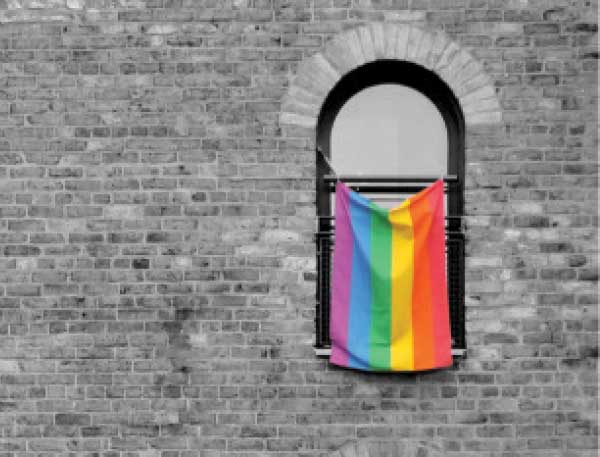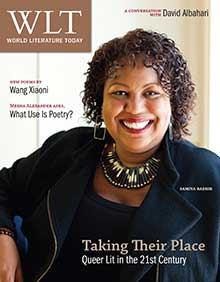Taking Their Place: Queer Lit in the Twenty-first Century
For guest editor George Henson, it’s been a long journey from reading The Front Runner in 1977 in Sapulpa, Oklahoma, to writing about queer lit for World Literature Today. But just as he has found his place here, the writers featured in this issue have taken their place alongside a long list of notable world authors.


I was sixteen when I first read the word “gay.” Growing up in small-town Oklahoma in the 1970s, “gay” was much too anodyne, if not sophisticated, to be used in everyday conversation. “Queer” and “faggot” I heard a lot. Those were epithets hurled like hand grenades in my high school at any boy who didn’t fit a very strict definition of masculinity. I wasn’t certain of many things in high school, but I was certain that I didn’t want to be called a queer.
I had heard the word “gay” before, but only in tandem with the word “bar.” One night as I watched the local five o’clock news with my family, the words “police raid gay bar” blared out of the TV set, accompanied by footage of handcuffed homosexuals being escorted out of a local gay bar. That was it: I knew I would never go to a gay bar.
The entire Western canon—from antiquity to the twentieth century—became the laboratory in which queer theorists could challenge heteronormativity and, in the process, dismantle not only homophobia but also sexism and racism.
A few months later, my life changed course during a trip to the local TG&Y. A five-and-dime chain that dotted small towns across the southern United States, TG&Y wasn’t the kind of place you expected to change your life. As I perused the book section, which consisted of four or five circular racks, a book cover caught my eye: a bespectacled runner sitting on what looked like a locker-room bench, an older man wearing only a white towel standing behind him. The book was Patricia Nell Warren’s The Front Runner. I picked it up and read the back cover: “Billy Sive is a brilliant runner who is a homosexual—and he doesn’t mind who knows it.” “Homosexual” was such an aseptic word. Until then I had only heard it used in Sunday sermons and read it in encyclopedias.
I clutched the book to my chest, glanced around to see if anyone was looking, and headed to the checkout. I paid the cashier, raced home, ran into my room, locked my door, and opened the book. The dedication page read: “Dedicated to all the athletes who have fought for human rights in sports, and to the young gay runner I met at a party, who gave me the idea for this book.” There it was: “gay.” And it wasn’t attached to “bar.” It was 1977. I was a senior in high school. And for the first time since I realized I was different at five years old, I felt like I had a future as a gay man. There were other people like me who weren’t arrested in gay bars.
In the fall of 1978, I went away to college. While queers in New York were celebrating Larry Kramer's Faggots, and San Francisco's burgeoning LGBT community was mourning the assassination of Harvey Milk, I was still searching for my gay identity and a community. One night, as I was doing research in the library for one of my Spanish classes, I came across a text on the gay Spanish poet and playwright Federico García Lorca. I had recited Lorca’s “Llanto por la muerte de Ignacio Sánchez Mejías” in high school at Spanish contests around the state. I was fascinated by his poetry, but the only thing I knew about his life was that he had been assassinated at the beginning of the Spanish civil war. The book referenced an “emotional crisis” that precipitated his trip to New York in 1929, during which he wrote Poeta en Nueva York. Although the text didn’t specify the cause of the crisis, thanks to my gay sensibility, more than any critical awareness, I knew the crisis; the amor invertido (inverted love) the writer referenced was Lorca’s homosexuality. I mustered up the courage to ask my professor the next day if Lorca had been gay. His curt response, “Eso no tiene nada que ver” (That’s irrelevant), verified my suspicion.
Years later, as I was studying in Spain and preparing my master’s thesis on the homosexual elements in Lorca’s Poet in New York, I encountered the same entrenched homophobia. “Lorca’s homosexuality had nothing to do with his poetry,” I was told. At least this time, the professor could bring himself to acknowledge Lorca’s homosexuality. Ironically, around that time, Lorca’s Sonetos del amor oscuro (Eng. Sonnets of Dark Love, 1989), which his family had attempted to censor, were circulating clandestinely. Nothing, indeed.
As I began my doctoral work, a group of scholars—Teresa de Lauretis, Eve Kosofsky Sedgwick, David Halperin, Judith Butler, and others—were founding the emerging field of queer theory, based, in large part, on Michel Foucault’s claim that homosexuality had been discursively constructed in the nineteenth century. Suddenly, everyone was attempting to digest, some with greater success than others, volume 1 of Foucault’s History of Sexuality: The Will to Knowledge. Thanks to Foucault, essentialism was out; socially constructed sexuality was in. Queers, or so it went, were not born; they were socially constructed by a heteronormative and homophobic culture. Not only were sexuality and gender social constructs, they were neither innate nor natural. Sedgwick’s Epistemology of the Closet, Halperin’s One Hundred Years of Homosexuality, and Judith Butler’s Gender Trouble were required reading.
Thanks to Derrida and poststructuralism, there was no fixed meaning in texts; traditional binary oppositions like homo- / heterosexual were unstable and subject to deconstruction. The entire Western canon—from antiquity to the twentieth century—became the laboratory in which queer theorists could challenge heteronormativity and, in the process, dismantle not only homophobia but also sexism and racism. Queer had become a verb in addition to a noun and adjective. Appropriated from LGBT activist groups like Queer Nation, who had reclaimed the one-time slur as a badge of resistance to the heteronormativity of the dominant, largely white, middle-class society, “queer” had become a politically charged signifier and identity category.
I offer the above anecdotes, along with a brief genealogy of queer theory, as an introduction to this section on queer lit to illustrate how far we’ve come since I discovered The Front Runner thirty-six years ago. Ironically, unbeknownst to me, I had already been reading queer lit: Wilde’s The Picture of Dorian Gray, Mann’s Death in Venice, Proust’s Remembrance of Things Past, Whitman’s Leaves of Grass, Lorca’s Poet in New York, Woolf’s Orlando. I can’t help but wonder if, in a high school or college classroom somewhere, a teacher is pointing out the homoerotic themes in Melville’s Billy Budd or Sor Juana’s “Love Opened a Mortal Wound.” Or if a Latina lesbian is being introduced to the life-changing writing of Gloria Anzaldúa.
The queer writers featured in this issue represent diverse languages, cultures, sexual identities, and genres. In spite of their diversity—or perhaps because of it—their works share a strong sense of queer identity. These are not writers writing from the margin. Although queer literature in the twenty-first century may still be relegated to minority status, critics are no longer tasked with teasing out queer themes and identities or debating the relevance of the authors’ sexuality to their work. Their queerness both constitutes and is constitutive of their writing.
Cuban American Achy Obejas erases the boundaries of gender, sexuality, and body in her poem “Genesis” (page 43). The title suggests that this is a creation story, and it is, which invokes both the biblical myth of genesis and something much more primal. Water becomes the locus for both birth and sex. Or are they indistinguishable? By invoking parthenogenesis, Obejas excludes the male from mating but not from the sexual act. The poem’s primary moment comes at the end, when the poetic and sexual synthesis of lesbian lover and father occurs:
I was looking for you –
his co-joined daughter,
my hermaphroditic lover.
I dreamt I made love to your father.
By the last stanza, the reader finally realizes that this creation story has been told in reverse. The lovers have, in fact, traveled back to their amphibian origins.
“Forgetting the Bodies” (page 44), by Cuban poet Norge Espinosa Mendoza, is an epistolary poem written to David, perhaps a former lover. The poet-narrator invokes the Hotel Monserrate, where the late gay Cuban poet Reinaldo Arenas lived after he was released from prison. The poet is haunted by the ghosts of places and memories, of moments of intimacy. The penultimate stanza functions as an eleventh-hour exhortation to return to the past, but in the last stanza, he accepts that the appeal is futile. His poem “My Life with Jeff Stryker” (online) is both an erotic bildungsroman and an ode to Jeff Stryker, one of the most idolized gay porn actors of the 1980s and 1990s. The poet reflects on his youth one night, as he lies in bed, looking at the naked photos that were passed around by hand in a country where pornography remains illegal. The act of possessing these photos represents at once a declaration of the poet’s erotic identity and an act of resistance against a repressive regime.
A nostalgic, lyrical “I” runs throughout Abdellah Taïa’s short story “Turning Thirty” (page 46). This semiautobiographical story picks up the theme of death and rebirth present in his debut novel, Salvation Army. This is a story of longing to belong, to feel comfortable in one’s own skin—as a gay man, as a dark-skinned Moroccan living in exile in Paris. In order to belong, he must become someone else, he must rename himself. The avuncular figure—the mentor—has a long tradition in homoerotic literature. Traditionally, he represents sexual knowledge. One wonders, however, if the relationship between the six-year-old Tristan, whom Taïa babysits, and the author represents the intimate relationship between Taïa and his older brother in Salvation Army. In the end, self-loathing is reborn as self-love.
One wonders if for “Zeroth Law” (page 49), Somali American poet Samiya Bashir is alluding to the zeroth law of thermodynamics or Asimov’s zeroth law of robotics. Both provide for interesting possibilities. This sonnet’s first line, “When leaning on the backyard beam,” is imitative of Whitman’s “When lilacs last in the door-yard bloom’d.” It establishes a somber tone, which is maintained throughout the first stanza. But thereafter the playful use of interior rhyme and alliteration and the creation of compound nouns like “swinghold” highlight the intertwining use of nature and corporeal imagery. An essentially unerotic poem suddenly becomes eroticized, albeit teasingly, when the reader arrives to “I’m not out for a jog or / to find a misplaced piece of scoundrel lover.” In “White Body Radiation” (page 49), Bashir tackles the social imperative of corporeal conformity. While deceptively simple in form, this poem does a great deal of work. It challenges the dual concept of “the body” as both a corpus of work and the human body. It teases out an artful and untamed beauty that already exists, despite cultural imperatives to contain and define it. Bashir invokes Keats when she asks, “What is a thing of beauty / If it’s not us?” If “Endymion” is a meditation on the nature of beauty and heteroerotic desire, Bashir’s “The Radiation of Whiteness,” then, queers Keats’s Western (read white) and heterocentric notions of beauty and love.
In “Heartbreak Hotel” (page 50), whose title is a play on Manuel Puig’s novel Heartbreak Tango, Colombian novelist Alonso Sánchez Baute employs the travel narrative as a vehicle to discuss the intersection of race, gender, and sexuality. After arriving in Rio de Janeiro, during a taxi ride to his hotel, he reflects on Leblón, the neighborhood in Rio where Puig, who was the 1991 Puterbaugh Fellow, lived with his mother in the 1960s. During his first outing, he is mugged by two black men. Baute uses this encounter to discuss the intersection of race and poverty. Later, on a second outing, having recovered from his earlier ordeal, he walks leisurely through Lapa, a “picturesque” neighborhood that was home to Rio’s bohemian artist community during the city’s belle époque, in particular to Madame Satã, a celebrated yet notorious transvestite. Poor, black, illiterate, homosexual, and a transvestite who was imprisoned for conspiracy to commit murder, Madame Satã becomes a synecdoche for the racism and homophobia that plagued Brazil.
During an email exchange, Nicholas YB Wong told me that he feels “linguistically inferior” because he is a Chinese poet who lives in China but publishes in English in the United States. Wong’s anxiety about writing in a foreign tongue is misplaced. His poetry displays a linguistic command that few poets achieve. When I asked what poets he admired, I was pleasantly surprised to hear that he read gay poet D. A. Powell—surprised because other than sharing a neoformalist and elliptical aesthetic, Wong’s unerotic verse has little in common with Powell’s homoerotic poetics. In “corydon & alexis,” Powell invokes at once Virgil’s second eclogue and Annie Proulx’s “Brokeback Mountain”:
shepherdboy? not the most salient image
for contemporary readers
nor most available. unless you’re thinking
brokeback mountain: a
reference already escaping. I did love a montana man, though no
good shepherd.
According to Wong, “Inside America” (page 47) evokes “America as an interior space housing the narrator who is trapped between the impulse to leave and the obsessive, fetishistic attention to details of the ‘house.’” Instead of an erotic poetics, however, Wong constructs poetics of place and belonging. The poem’s primary moment occurs when Wong exhorts the reader, “Call me faggot,” an echo of Melville’s “Call me Ishmael,” in which faggot, like Ishmael, serves as a metonym for the Other. This imperative not only marks a shift from first to second person, establishing the reader as interlocutor, it also functions as an act of self-naming, a positive declaration of queer identity.
We’re excited to offer online not only Bashir’s poems “Zeroth Law” and “White Body Radiation” (in print and audio format) and Espinosa’s poem “My Life with Jeff Stryker,” but also three poems by Burmese poet ko ko thett and Polish poet Edward Pasewicz.
As you may have noticed, I have a tendency to discover lines or motifs that invoke, at least for me, other poems. Some of these allusions no doubt are intentional on the poets’ part, while others may be incidental if not subconscious. In either case, these genealogies are important because they demonstrate the deep and interwoven roots of poetry and the human experience.
For example, as I was reading ko ko thett’s “Let Us Suppose You Love Me,” I couldn’t help but think of Nicanor Parra’s “Autorretrao” (Self-portrait). Both works, after all, begin with imperatives. Both address interlocutors. And both are confessional poems, or antipoems, which ask their readers to consider a series of biographical facts or propositions. In Parra’s “Self-portrait,” the poet-narrator is a teacher who has “lost his voice teaching classes” and no longer “recognizes his mother,” having “ruined his eyes” in the “bad light, the sun, / the miserable poisonous moon.” In “Let Us Suppose You Love Me,” the poet-narrator suffers extreme physical abuse, having been “caned” and “stripped naked.” Like Parra, thett could have named his poem “Self-portrait.” Ironically, while both poems employ physiological imagery, they are actually psychological portraits. Parra asks that we consider, “Why were we born as men / If we are given the death of animals!” This same question, which is implicit in “Let Us Suppose You Love Me,” more than any formal or rhetorical elements, links thett to Parra.
On the surface, the similarities between Pasewicz’s “Essay on Caution” and William Carlos Williams’s “This Is Just to Say” are incidental; that is, they’re both ostensibly poems about eating plums. While a sexual reading of Williams’s poem, in which the plum can be read as a metaphor for forbidden fruit, is plausible and defensible, the imagery of the plum as an erotic metaphor in Pasewicz’s poem is much more readable. As the title suggests, this poem is not an apology for eating the plum but rather a cautionary tale: for homosexual desire, more explicitly an act, in which a chance or anonymous encounter is a source of shame. Or is it?
In “He Liked This,” Pasewicz offers us an ode. Unlike “Essay on Caution,” this is not a poem about regret or shame. On the contrary, its purpose is celebratory. The poet’s anaphoric use of “He liked” not only adds emphasis, it also creates a playful, even pleasurable attachment to the subject of this poem. This is, after all, a poem about sexual pleasure, hence the poem’s penultimate line: “He liked a hot boyish tongue on his lips.” Like many of the works in this section, indeed much of queer literature, the last line, “he liked to call it by name, though it doesn’t have a name,” invokes the imperative to name the unnamed or, in this case, the unnamable.
I began this essay by saying that I never wanted to be called queer. Today I welcome it. Like the writers featured in this issue, my queerness informs who I am and how I see the world. It’s been a long journey from reading The Front Runner in 1977 in Sapulpa, Oklahoma, to writing about queer lit for World Literature Today. Just as I have found my place here, the writers featured in this issue have taken their place alongside a long list of notable world authors.
Dallas, Texas











